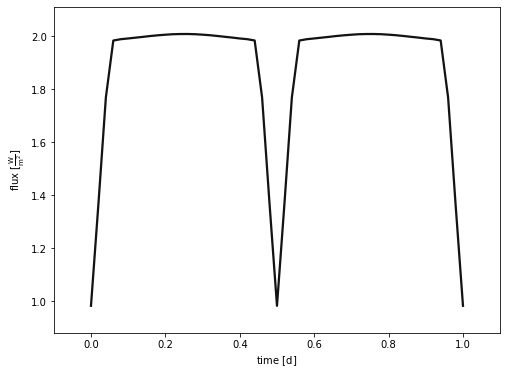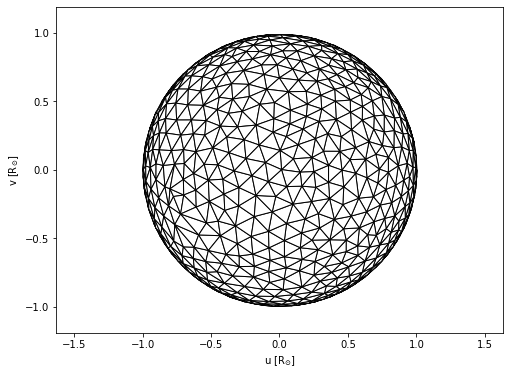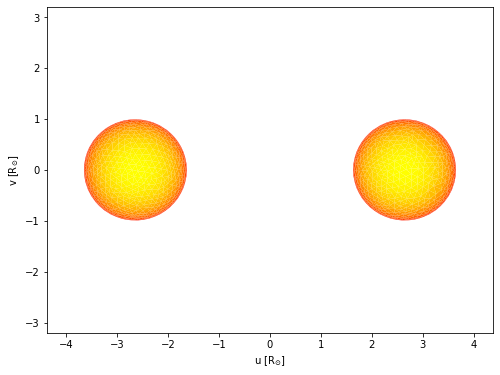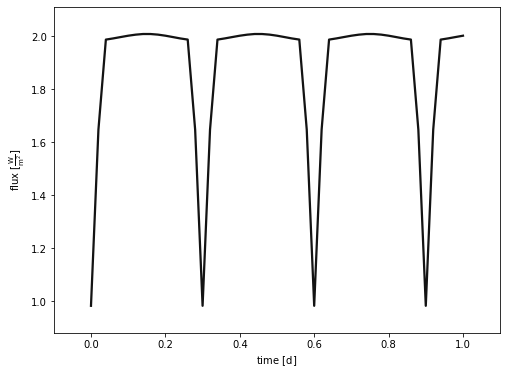Eclipsing Binaries and Asteroseismology

Precise fundamental stellar parameters in the golden age of time-domain astronomy
import phoebe
from phoebe import u,c
import matplotlib.cm as cm
logger = phoebe.logger(clevel='WARNING')
Phoebe is capable of building all kinds of heirarchies, but the simplest way to begin is by loading the default binary and then changing its parameters as we wish
b = phoebe.default_binary()
This object is known as a ‘bundle’ and contains all the parameters of the system as well as some callable methods.
b
<PHOEBE Bundle: 141 parameters | contexts: component, system, figure, compute, setting, constraint>
Let’s investigate parameters related to compute contained in the bundle
print(b['compute'])
ParameterSet: 17 parameters
sample_from@phoebe01@compute: []
comments@phoebe01@compute:
use_server@phoebe01@compute: none
dynamics_method@phoebe01@co...: keplerian
ltte@phoebe01@compute: False
irrad_method@phoebe01@compute: horvat
boosting_method@phoebe01@co...: none
eclipse_method@phoebe01@com...: native
horizon_method@phoebe01@com...: boolean
mesh_method@primary@phoebe0...: marching
mesh_method@secondary@phoeb...: marching
ntriangles@primary@phoebe01...: 1500
ntriangles@secondary@phoebe...: 1500
distortion_method@primary@p...: roche
distortion_method@secondary...: roche
atm@primary@phoebe01@compute: ck2004
atm@secondary@phoebe01@compute: ck2004
Can access these parameters through twigs (minimum string required to define a particular parameter) or filters
b.filter(context='compute', component='primary', qualifier='ntriangles').get_parameter()
<Parameter: ntriangles=1500 | keys: description, value, limits, visible_if, copy_for, readonly, advanced, latexfmt>
b['ntriangles@primary@compute']
<Parameter: ntriangles=1500 | keys: description, value, limits, visible_if, copy_for, readonly, advanced, latexfmt>
In the same way, we can set these parameters
b['ntriangles@primary@compute']=200000
b.filter(context='compute', component='primary', qualifier='ntriangles').set_value(1500)
Before we can actually run a model, we need to tell phoebe what to evaluate. Is it a light curve? RV curve? Orbit? At what times? We do this by adding datasets (which can include the real data for comparison).
b.add_dataset('lc', times=phoebe.linspace(0, 1, 51)*u.d, dataset='lc01',passband='Johnson:V')
<ParameterSet: 80 parameters | contexts: figure, dataset, constraint, compute>
b.run_compute()
b.plot(show=True)
100%|██████████| 51/51 [00:01<00:00, 48.51it/s]

(<autofig.figure.Figure | 1 axes | 1 call(s)>,
<Figure size 576x432 with 1 Axes>)
Another example: meshes
b.add_dataset('mesh', compute_times=[0,0.25], dataset='mesh01')
<ParameterSet: 85 parameters | contexts: figure, dataset, constraint, compute>
b.run_compute()
Fri, 16 Sep 2022 14:28 BUNDLE WARNING overwriting model: latest
100%|██████████| 52/52 [00:01<00:00, 43.64it/s]
<ParameterSet: 21 parameters | kinds: lc, mesh>
b['mesh01@model'].plot(time=0,show=True)

(<autofig.figure.Figure | 1 axes | 2 call(s)>,
<Figure size 576x432 with 1 Axes>)
b['mesh01@model'].plot(time=0.25,show=True)

(<autofig.figure.Figure | 1 axes | 2 call(s)>,
<Figure size 576x432 with 1 Axes>)
Meshes can even be plotted with face colours that represent temperature or intensity
b.add_dataset('mesh', compute_times=[0.24], dataset='mesh02',columns=['visibilities', 'intensities@lc01'])
b.run_compute()
b['mesh02@model'].plot(fc='intensities@lc01', ec='None',fcmap=cm.autumn,show=True)
Fri, 16 Sep 2022 14:28 BUNDLE WARNING overwriting model: latest
100%|██████████| 52/52 [00:01<00:00, 46.57it/s]

(<autofig.figure.Figure | 1 axes | 2 call(s)>,
<Figure size 576x432 with 1 Axes>)
If we have time, you might want to play around with changing the parameters of the stars and/or orbit, in order to see what effect those changes have on the light curve. There are plenty to choose from!
print(b['component'])
ParameterSet: 62 parameters
requiv@primary@component: 1.0 solRad
C requiv_max@primary@component: 2.013275176537638 solRad
teff@primary@component: 6000.0 K
abun@primary@component: 0.0
C logg@primary@component: 4.437551877570185
syncpar@primary@component: 1.0
C period@primary@component: 1.0 d
C freq@primary@component: 6.283185 rad / d
pitch@primary@component: 0.0 deg
yaw@primary@component: 0.0 deg
C incl@primary@component: 90.0 deg
C long_an@primary@component: 0.0 deg
gravb_bol@primary@component: 0.32
irrad_frac_refl_bol@primary...: 0.6
C irrad_frac_lost_bol@primary...: 0.4
ld_mode_bol@primary@component: lookup
ld_func_bol@primary@component: logarithmic
ld_coeffs_source_bol@primar...: auto
C mass@primary@component: 0.9988131358058301 solMass
requiv@secondary@component: 1.0 solRad
C requiv_max@secondary@component: 2.013275176537638 solRad
teff@secondary@component: 6000.0 K
abun@secondary@component: 0.0
C logg@secondary@component: 4.437551877570185
syncpar@secondary@component: 1.0
C period@secondary@component: 1.0 d
C freq@secondary@component: 6.283185 rad / d
pitch@secondary@component: 0.0 deg
yaw@secondary@component: 0.0 deg
C incl@secondary@component: 90.0 deg
C long_an@secondary@component: 0.0 deg
gravb_bol@secondary@component: 0.32
irrad_frac_refl_bol@seconda...: 0.6
C irrad_frac_lost_bol@seconda...: 0.4
ld_mode_bol@secondary@compo...: lookup
ld_func_bol@secondary@compo...: logarithmic
ld_coeffs_source_bol@second...: auto
C mass@secondary@component: 0.9988131358058301 solMass
period@binary@component: 1.0 d
C freq@binary@component: 6.283185 rad / d
dpdt@binary@component: 0.0 s / yr
per0@binary@component: 0.0 deg
dperdt@binary@component: 0.0 deg / yr
ecc@binary@component: 0.0
C t0_perpass@binary@component: -0.25 d
t0_supconj@binary@component: 0.0 d
C t0_ref@binary@component: 0.0 d
C mean_anom@binary@component: 89.99999559997653 deg
incl@binary@component: 90.0 deg
q@binary@component: 1.0
sma@binary@component: 5.3 solRad
long_an@binary@component: 0.0 deg
C asini@binary@component: 5.3 solRad
C ecosw@binary@component: 0.0
C esinw@binary@component: 0.0
C teffratio@binary@component: 1.0
C requivratio@binary@component: 1.0
C requivsumfrac@binary@component: 0.37735849056603776
C sma@primary@component: 2.65 solRad
C asini@primary@component: 2.65 solRad
C sma@secondary@component: 2.65 solRad
C asini@secondary@component: 2.65 solRad
b['period@binary']=0.6*u.d
b.run_compute()
b['lc01@model'].plot(show=True)
Fri, 16 Sep 2022 14:28 BUNDLE WARNING overwriting model: latest
100%|██████████| 52/52 [00:00<00:00, 57.61it/s]

(<autofig.figure.Figure | 1 axes | 1 call(s)>,
<Figure size 576x432 with 1 Axes>)
You will often run into issues with parameters going out of acceptable ranges. Also, remember that we are sampling the model light curve only at the time we defined earlier when adding the lc dataset - this can lead to artefacts in the plotted curve!